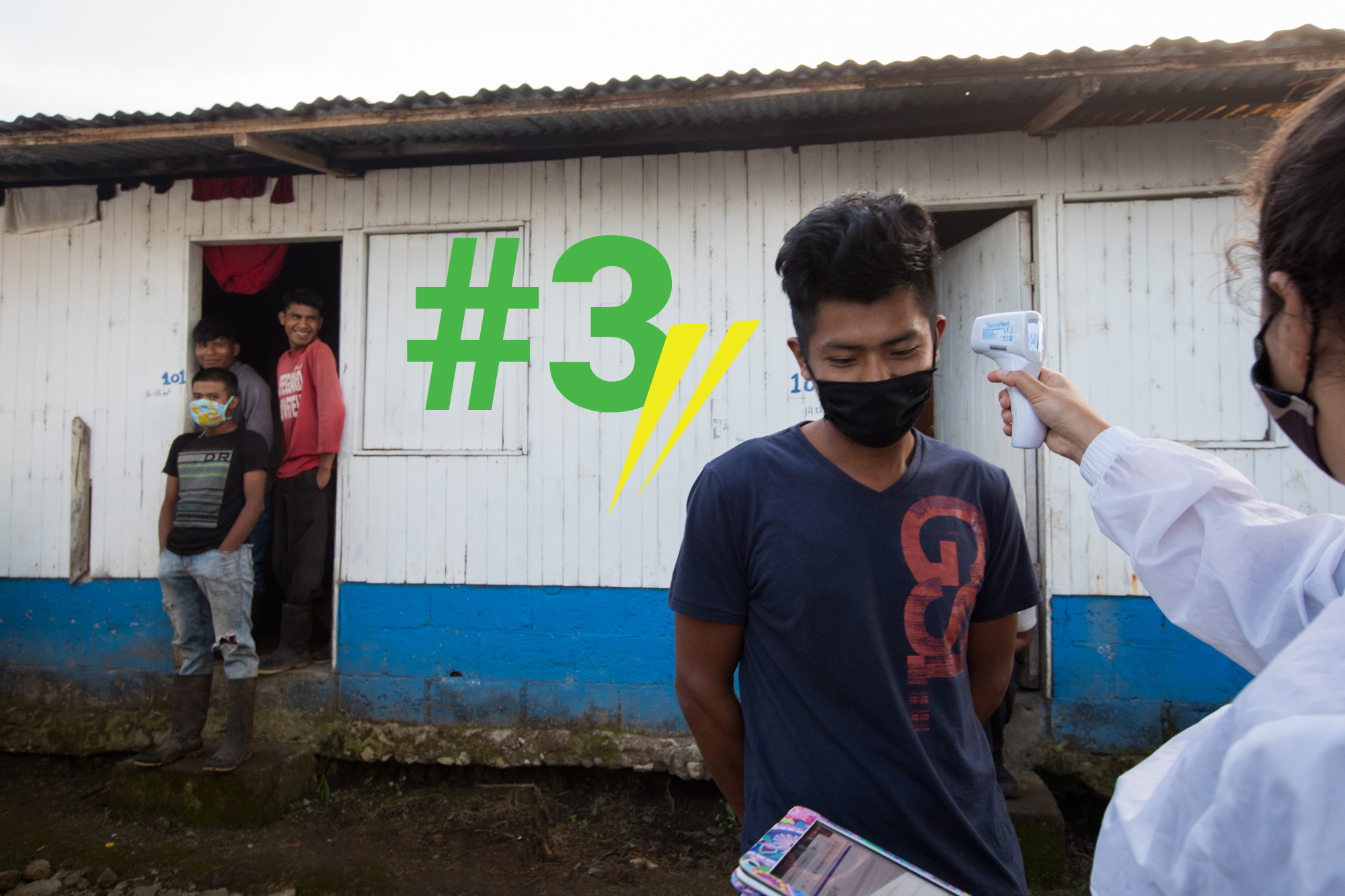
Read Part One, “A harvest turned upside down,” and Part Two, “The 48-hour journey.”
Sergio’s friends are laughing at him.
As the lanky 22-year-old stands in the shadows and wood smoke, in the roofed space outside the dormitories where coffee workers are cooking their evening meals over fires in a long cement trough, a group of men across the way keep glancing over with sly grins and offhand comments. They find it funny that two journalists are interrogating Sergio, one with a camera trained on him as he talks. Sergio himself seems embarrassed, but willing to speak. He has been picking coffee all day at Finca La China, one of the largest farms in the southern Costa Rican border region of Coto Brus.

Monica Quesada Cordero/El Colectivo 506/
It’s not the first time. On his second day of work—during this, his first-ever coffee harvest—he was teased because of our presence, as well. We captured some of his very first moments navigating the glossy green leaves and multicolored fruits he would come to know so well. He shrugged this aside, concentrating on trying to pick reddish coffee cherries from among the green. This is called picking en granea, when only some of the fruits are ripe, necessitating a more painstaking process than when almost all are ripe and pickers can just strip the whole branch. Around him, more experienced pickers carried out this task with flying fingers and a steady drum of hard beans into the plastic basket, worn around the waist.
“My hands are stiff,” he says.
Now, three weeks later, as a steady rain drums on the roof of the cooking area, he says he’s doing better. He’s getting the hang of things at Finca La China, so named because it was previously owned by a Chinese family. Sergio has completed his two-week quarantine, which he spent picking coffee; here, workers stay in isolated social bubbles while working during their quarantine, which is easy on such a large farm. He has now worked his way up to picking about six cajuelas per day for a daily earning of 7,320 colones (about $12). At the end of the day, he hoists his cajuelas into a truck where farm leaders measure out the beans, then replace them in the basket with tokens and hand them back down to the worker.
After this process, the medida (measurement), the workers line up at the farm’s central offices—in the open air, wearing masks, with social distancing strictly observed—and exchange the tokens for coins. They can tuck those away or spend them at the farm store, where bags of candies and plantain chips hang from the ceiling. A little stand with used clothing offers up sweatshirts and jeans for coffee pickers who need to replenish their hard-working wardrobes. Rainjackets are not in demand: many workers, here and throughout the country, use a garbage bag as a cheap and lightweight covering as they pick.
COVID-19 protocols are posted everywhere and strictly observed throughout the workday. However, it’s the structure behind Sergio as he talks to us now that has been subject to the most intense scrutiny and debate in Costa Rica’s mid-pandemic coffee industry this year—and for many years before that. It’s the bache, the dormitory where workers sleep in between hard days of work in the fields. They are so called because they were designed for bachelors, although there is family life all around Sergio as he stands in the wood smoke. The word is less common as one moves north, where albergue, or shelter, is frequently used. But whatever its name, the housing provided to migrant coffee workers is one of the biggest issues raised by defenders of indigenous rights.
During a global pandemic, issues that, according to people across the industry, have long been ignored—such as a lack of potable water, electricity or bathroom facilities at worker residences—have become un-ignorable. Farmers who had watched Northern Zone agricultural facilities be shut down after COVID outbreaks knew that there was no room for error. Living conditions that could support COVID-19 prevention and containment on Costa Rica’s coffee farms had suddenly become a matter of literal, and economic, life and death.
Variations on a theme
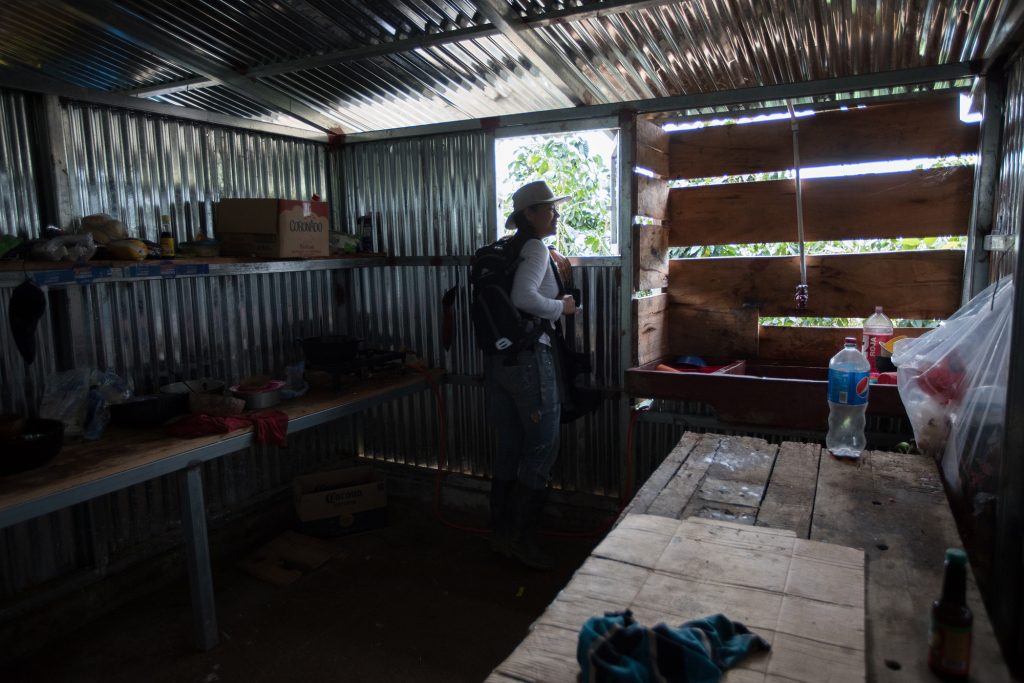
Monica Quesada Cordero/El Colectivo 506/National Geographic Society Covid-19 Emergency Fund
The first time Lucidia Hernández walks into her brand-new workers’ shelter, she claps her hands with glee. “Ay, qué lindo,” she says, catching sight of a window in the kitchen area that opens out onto the dramatic, rippling mountains of the Valley of the Saints. “I hadn’t seen this part!” The reason this is her first time inside this new building is her little daughter Ruth, who has made the brisk trek up the mountain in a baby carrier. Lucidia hasn’t spent as much time out in the fields this year as she usually might.
The corrugated zinc used inside and out is shiny and new. Bunk beds and room divisions comply with government requirements for worker housing. Beans are burbling on the gas stove. The residents of this home are sprawled outside, their workday finished: they are relaxing after the medida, enjoying the sun in a region where thick mists sweep in at a moment’s notice.
Lucidia has never had a workers’ shelter on her farm before. She and her husband, Minor Montero, the co-founders of Tierra Amiga Tarrazú, need about a dozen workers each year to help them with their annual harvest on their farm above the town of San Marcos. In the past, these workers stayed in accommodations elsewhere. In 2019, the couple made plans to build a shelter on their farm, for various reasons.
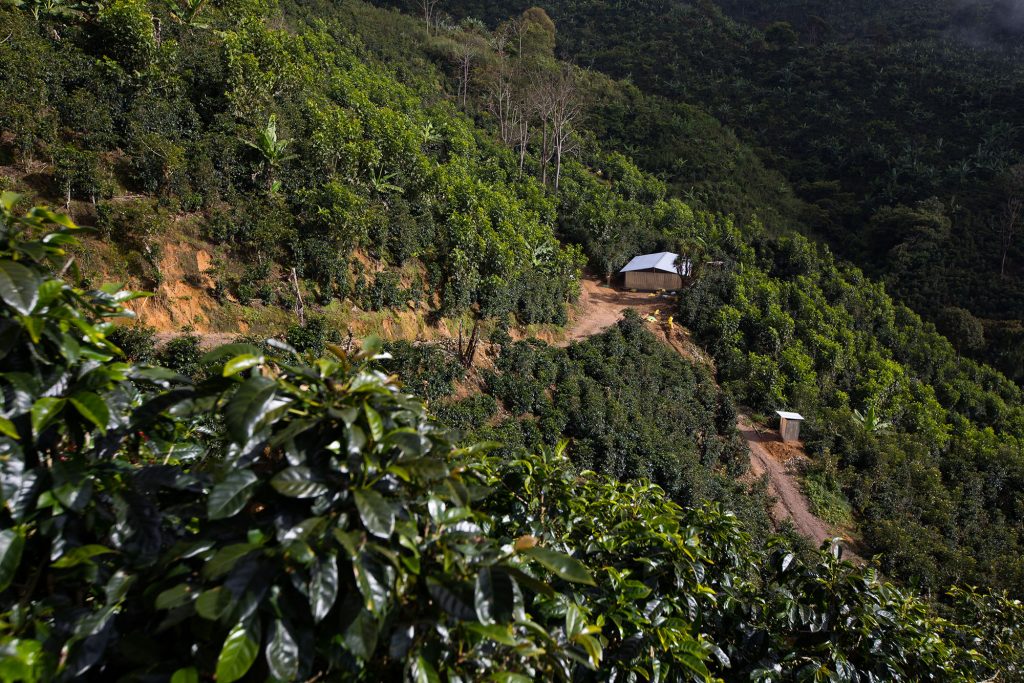
“It was something we’d planned to do, COVID or no, because we saw that when the workers had to be transported from one place to another… it was tiring for them, and for me as the driver, as well,” says Minor. “We had to take them maybe 20 kilometers away.” So the family planned to build their structure, which would cost 3 million colones, approximately $5,000. In order to afford it, they worked out a credit with Ferretería Elena, their local hardware shop. To reduce the cost of labor, Minor participated in the construction himself, the equivalent of two weeks’ full-time work.
They were able to make some choices: using corrugated zinc instead of wood, for example, and soldering the metal bunk beds to the walls. (“Only something very violent would damage those,” says Minor. “Among the people who come to pick coffee, there are very decent people, but there have been cases of people… who’ll take [wood] in pieces right out of a house and burn it” in their cooking fire.) However, other requirements for the structure, such as the minimum space it must provide for each person who lives there, are stipulated in a detailed guide emitted in 2020 by the Ministry of Health for worker shelters during COVID-19. The guide’s 18-point evaluation criteria include requirements for walls and flooring, toilets, roofs, showers, potable water, and COVID-19 signage, and more.
“I have to be honest,” says Felix Monge, field coordinator for Coopetarrazú, the country’s largest coffee cooperative, when asked how many of the regulations were new this year. “I think there’s always been a base [requirement] for what the coffee pickers’ shelter has to comply with, but maybe it has never been given much attention. But this year, with the pandemic, it’s a very relevant issue, because a shelter in poor condition can become a focal point for contagion. What’s more, all the institutions are watching what’s going on.”
As a result, Coopetarrazú—and more specifically, the unit Felix runs—scaled up its inspection of workers’ shelters drastically this year, visiting close to 2,000 dormitories belonging to its farmers. While Coopetarrazú represents 5,000 coffee producers, 86% of those have fewer than four hectares, he explains; many of those small farmers don’t need to receive migrant workers for their harvest. The rest, Felix’s team visited, noting failures to comply with regulations and making credit lines available to farmers that needed to make improvements or build new facilities.
Of the 1,671 dormitories Coopetarrazú inspected in its first round of visits in 2020, 832 were ordered to make improvements, Felix says. He adds that he’s witnessed “a truly spectacular leap in the conditions we have in the shelters. They aren’t luxury mansions, I have to say, but just the fact that the Health Ministry is making direct verifications [has made a difference], and the results have been good.”
How have producers reacted to these new regulations during an already stressful year?
“Depending on the debt that farmer had [with providing adequate living conditions]. That determined the reaction. But everyone has understood the situation,” he says. “We can be the best at producing coffee, but this year many producers have had a crash landing, realizing the extreme importance of the coffee pickers in the productive chain… You can do a great job [raising coffee] for nine months, but if those pickers don’t arrive for X or Y reason, or especially because you haven’t provided the right [living conditions], you’ve done terrible damage to your family economy.”
The requirement that farmers provide shelters with electricity might sound basic—until you walk to some of the farms. Lucidia explains that to adding electricity to their new shelter would cost 4 million colones, more than the building itself. They are looking into installing a solar panel. In the meantime, her workers, like most of those we meet at farms throughout our reporting, cook on wood stoves and turn in early. They use cell phones that Minor or, today, Lucidia, collect and take down to the family’s house in town to recharge. Fortunately, the farm has its own water source, so that potable water for workers is not an issue. Lucidia says she shares her water with neighboring farms.
Farmers like Lucidia who have worker accommodations within their farms are saved a lot of headaches during the pandemic. Quarantine? The workers are already living in near-isolation. Contagion during transport? Not an issue. The one change to cafetal living this year, for workers deep within the fields, has been that they are discouraged, even post-quarantine, from emerging into nearby towns to buy food or supplies, or to go out for a drink.
“We tell them, you stay here. Whatever you need, we’ll bring to you,” says Lucidia, feeding her daughter as her workers look on, some eager to hold the baby once she’s done. During the medida, Ruth sits with her mother, playing with coffee cherries. As the men heft the 50-kg bags of coffee onto the truck and measure out the cajuelas, Lucidia marks down each worker’s totals in a little notebook so she and Minor can pay them at the end of the week.
She has spent much of her life in coffee fields and has served as a capataz, who assigns to the workers to their areas for the day. Striding through her farm in her jeans, boots and hat, calling to her foreman—Ngöbe man Johnny Saldaña Montezuma, 48—with a shout and a whistle, it’s easy to see how she runs this show.
“There are employers who treat the people who work for them as if they were inferior,” she says. “That just can’t be. Ever.”
Maikol’s whiteboard
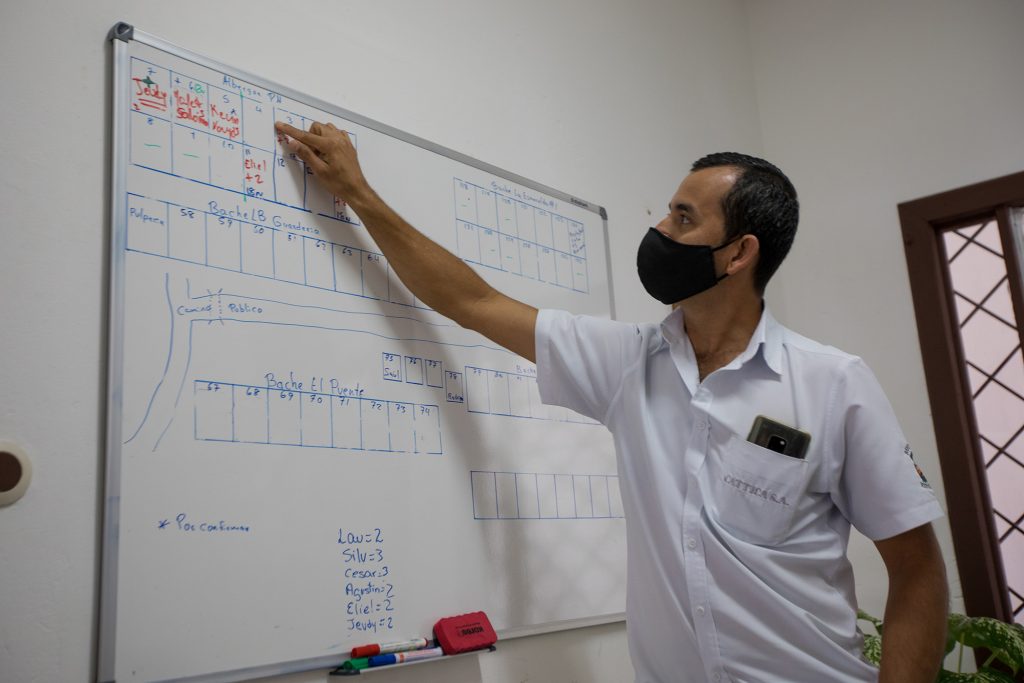
Monica Quesada Cordero/El Colectivo 506/National Geographic Society Covid-19 Emergency Fund
The only things that Finca Río Negro, in Coto Brus, has with Lucidia and Minor’s family cafetal are the beans, the bunkbeds, and the woodsmoke. Everything else looks very different.
For starters, there’s Maiko Valverde’s whiteboard. In careful lines and with meticulous care, he’s sketched out the sectors, dormitories, and COVID-19 bubbles of Coto Brus’s largest farm, which normally hires 600 or 700 workers at the peak of the harvest. This year, Río Negro gives each of its employees a rubber bracelet, color-coded to show which part of the farm that person can access. Its cement baches, painted white with blue accents—as he shows off the buildings, Maikol laments the way the workers’ football games tend to stain the white paint with muddy ball marks—can hold 850 people, although this year, thanks to the stress and strains of the border issues, the farm has only 260 at the time of our visit in mid-November. (“If we don’t get at least 150 coffee pickers in the next eight to 10 days, we’ll be in serious trouble,” he says.)
Yes: for starters, there’s that whiteboard. Then there’s the COVID.
As one of the biggest farms in the country, as well as a Rainforest Alliance-certified facility, Río Negro had to make sure its capacity to correctly isolate any workers infected with COVID-19 crossed every t and dotted every i. In August, they began renovating a dormitory to be used exclusively COVID-19 isolation: it’s a large structure with four areas where people could be separated. In October, the construction crew began putting the finishing touches on the structure and the driveway leading up to it.

Monica Quesada Cordero/El Colectivo 506/National Geographic Society Covid-19 Emergency Fund
They didn’t get to finish, because Maikol and his team had to start putting people into the building. On October 27th, the first case of COVID-19 was detected on the farm, a worker who went to the hospital with symptoms of diarrhea; she was diagnosed and returned, this time to Río Negro’s isolation area. But the Health Ministry testing triggered by the first case detected a number of other cases, meaning that dozens of positive cases and their family members or housemates had to isolate without picking for two full weeks.
Maikol walks us through the process, gesturing to the whiteboard marks that show how the workers were isolated and moved around. Every single one of the Río Negro cases was asymptomatic, with only a few exceptions. One was the very first case, and another was a worker who fainted in the fields and turned out to have both COVID-19 and Guillain-Barre syndrome. He had to be taken to a San José hospital for treatment in the ICU.
Fortunately, the COVID-19 shelter was ready to isolate the infected workers. It shelter stands well apart from the rest of the farm’s facilities, near a bend in the river that gives the farm its name. (Very few farms in Costa Rica are sizeable enough to have their own isolation quarters. In Tarrazú, Cooperatarrazú built a massive field hospital with capacity for 250 patients; it lies waiting, mostly empty, in the municipal stadium of San Marcos de Tarrazú. As a result, the region of Los Santos, which has some of Costa Rica’s lowest rates of COVID-19 infection, is also one of the best-prepared for a wave of cases.)
Two of the four sections of the Río Negro building were evacuated and fully disinfected earlier today. In the back half of the building, Agustín Santo, 38, his brother and cousin, and other positive cases have been isolating for several days.
“We’re healthy. We’re following the protocols,” shrugs Agustín, whose broad smile and blunt way of talking fills the conversation with laughter, despite the situation. “The law is the law.”

Monica Quesada Cordero/El Colectivo 506/National Geographic Society Covid-19 Emergency Fund
Eliel de Jesús Mora, 24, is a Nicaraguan who lives in Guanacaste, Costa Rica’s northwestern province. He is married to a Costa Rican, Katherine, and their two-year-old, Junior, plays around his father’s legs as he talks; Katherine is from Coto Brus, and has been picking coffee at this farm for years. Eliel met her here when he came to work at Río Negro four years ago.
“The baby isn’t used to being closed in like this,” he says. “Where we live, we have a patio, lots of space… He’s so innocent that he doesn’t know what’s happening.”
He says that he’s told his family in Nicaragua that he tested positive, but “there in our country, it’s not given that much importance. It’s not that we don’t believe there’s an illness, but we treat it like any other.”
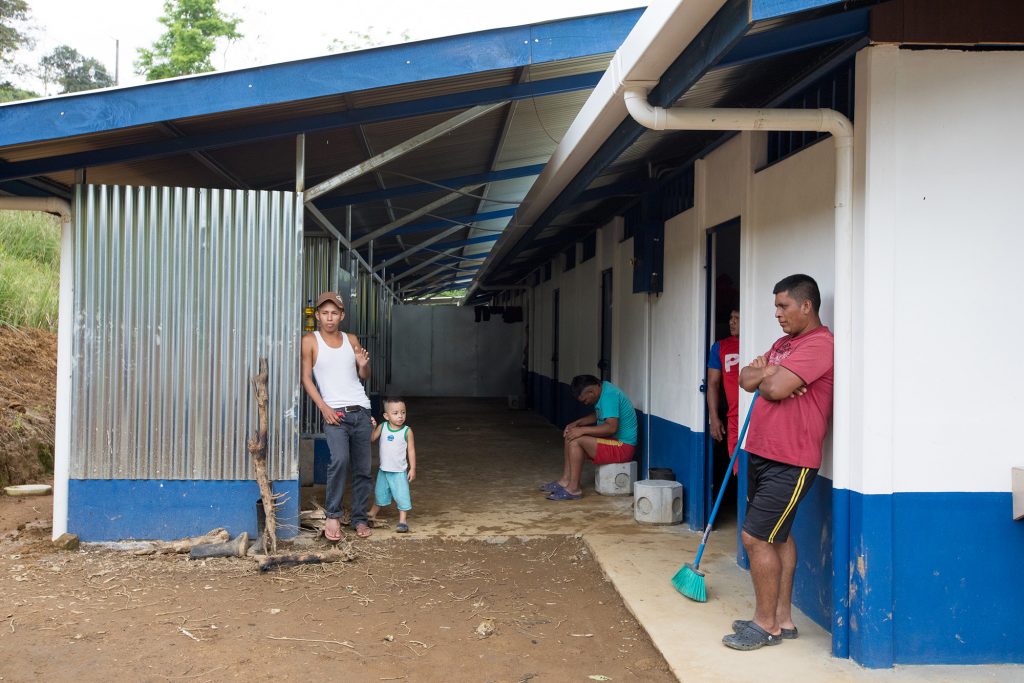
Resignation and no small dose of amusement at the fear of COVID among white people (also called Latinos in this region to distinguish them from indigenous peoples) runs freely through Agustín and the relatives who’ve been isolated with him, all asymptomatic.
“We’re not worried. This disease, if you get it, you get it… White people are dying from fear. They’re scared for nothing,” Agustín says, explaining how confusing it has been to be told he has a disease with no symptoms and no treatment. “They just ask us if we’re well or if we’re sick, but they don’t give us medicine!”
He relates that his 100-year-old grandfather, deep in the comarca, somehow got sick with COVID. “One of our caciques told us what he had to take,” so the family found the right herb in the forest and the grandfather was cured. We ask which herb it was. “I’m not telling you!” he says with an easy laugh, cracking up the group.
Up in the fields, Ubildo Hurtado Serrano, 28, has a different attitude. He left isolation just this morning along with his girlfriend, Delmira; they are back at work for the first time since testing positive for COVID-19. Ubildo had been at Río Negro for nearly two months when an farm administrator informed him, picking coffee one afternoon, that he had tested positive for COVID-19 and had to stop working.
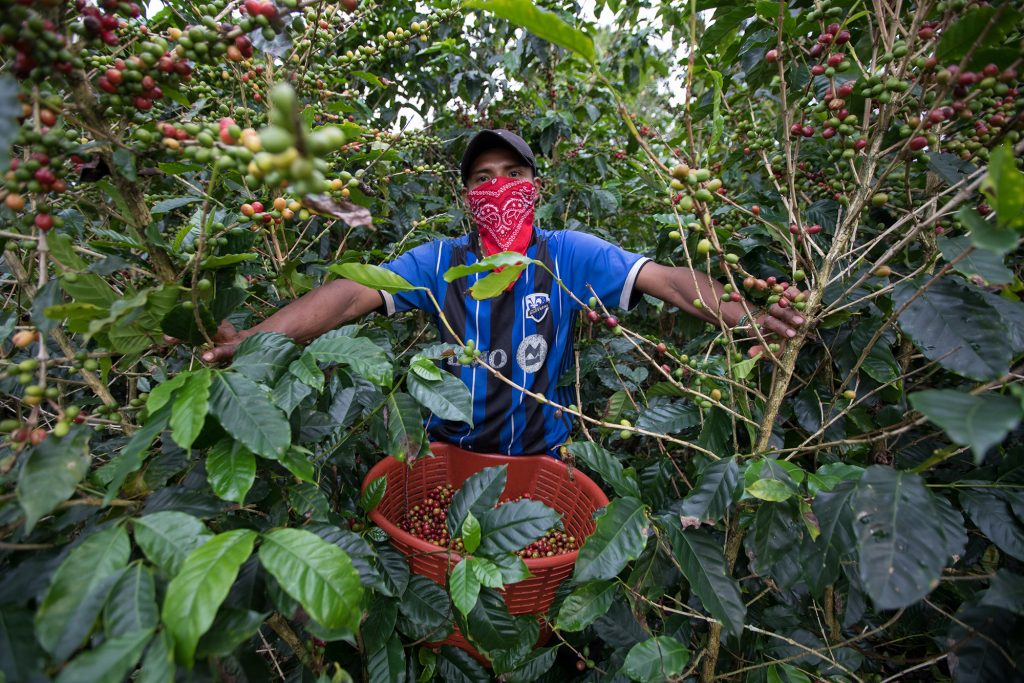
Monica Quesada Cordero/El Colectivo 506/National Geographic Society Covid-19 Emergency Fund
“I said, ‘With this illness, you don’t play around,’” he says. “Your life is worth more than money.” He figures he contracted the illness through his brother, who plays arcade games at a general store near the coffee field. “They don’t wash their hands,” he says. “There’s no reason to play the maquinita, that little machine… I haven’t told my mom [back in Panama] because she’d have a heart attack.”
Laura Abrego, 22, just left isolation as well after her positive COVID-19 test. She is five months pregnant, which is why she is now resting at the bache. Laura is a woman of few words as she stands in her red dress outside the bache, laundry drying overhead, people cooking and kids shouting at another bache higher up the hill behind her.
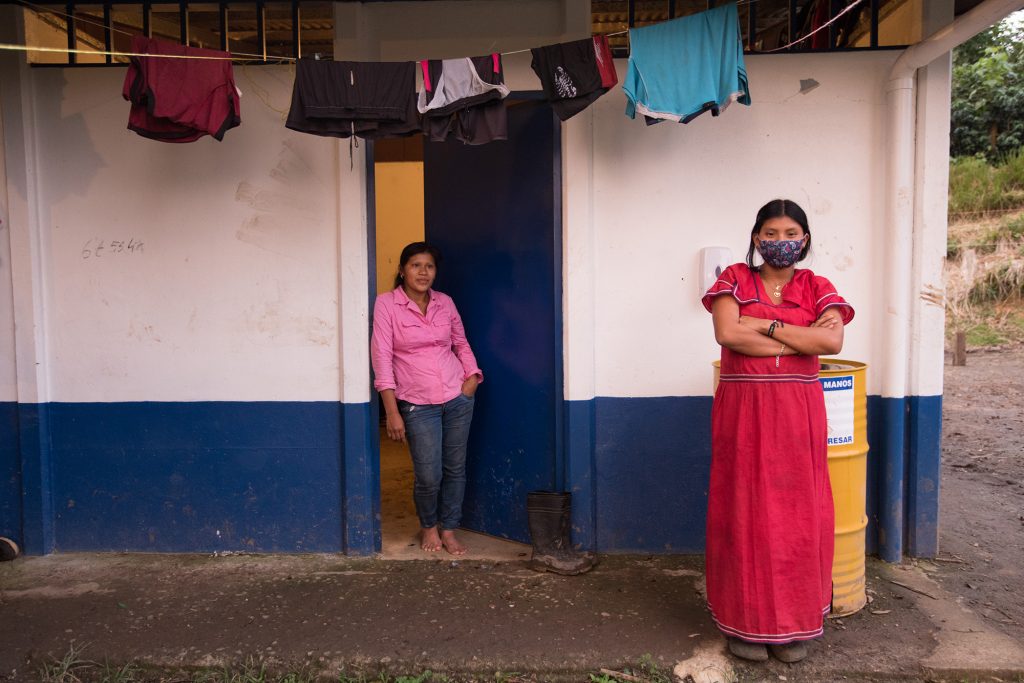
Her husband files by, and we ask how many cajuelas he picked today. Three is the answer. Laura winces, an eloquent “oh, come on” expression. Three cajuelas en granea is worth only about 3,600 colones. Less than $5.
Family life
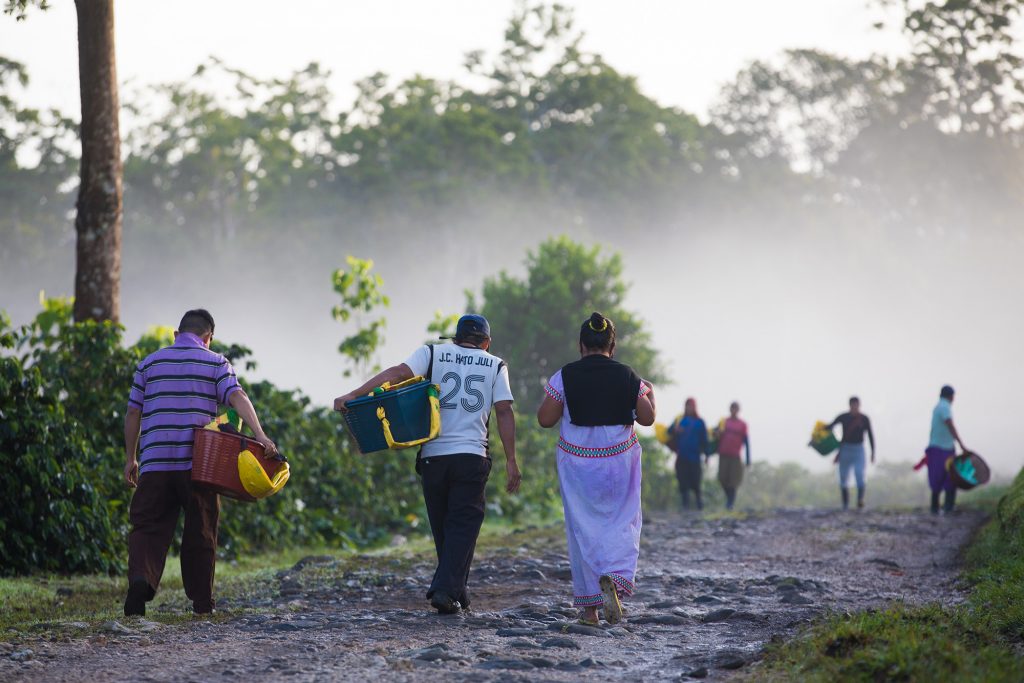
Monica Quesada Cordero/El Colectivo 506/National Geographic Society Covid-19 Emergency Fund
Women and children are a ubiquitous part of the Ngöbe-Buglé coffee migration in a usual year. Maikol says, with a combination of bemusement and exasperation, that it can be very hard for administrators at a big farm like Río Negro to keep track of due dates; he says that oftentimes, a woman will arrive and say she is a few months pregnant, and then within a couple of weeks, the baby has been born. We’re told that Costa Rica’s free, universal healthcare system is a draw for Panamanian women who know their local hospitals might charge them for diapers, for example.
This, too, has been different in 2020. Authorities on both sides of the border discouraged migrant workers from coming to Costa Rican with their children or with pregnant women, mostly through radio broadcasts through the comarca and word of mouth. Some Ngöbe-Buglé workers we spoke to understood—whether through intentionally misleading information, or miscommunication—that they were not allowed to bring their families, and were disappointed when, at the border, they learned it was merely a recommendation and that there was no rule against it. At any rate, coffee farmers and authorities alike have reported fewer children than ever before in this year’s harvest, and far lower numbers of pregnant women.
Different players in the coffee industry see this differently. It reduces costs for farmers, since COVID-19 health regulations mandate a minimum space that must be available in the dormitories for each person, whether child or adult—so a family coming with multiple children drastically increases the housing needed without increasing the number of available workers. However, others argue that an increase in single men in the coffee fields has been bad for farmers, because the workers are more likely to move from farm to farm.
“The fact that they can’t come with the whole family, I think it’s making the process very frustrating for them,” says Maikol, of Finca Río Negro. “It’s creating a lot of instability among those who are coming… Usually they come as a family and are united in the process.” He explains that when the workers are single men without their family, it’s much less likely that workers will stay put; during the week of our interview, Río Negro has lost 80 workers to other farms, a huge blow.
“This year has brought out my gray hairs,” says the impeccably coiffed administrator with a wry smile.
The shift has meant that many of the public-private Casas de la Alegría, Houses of Joy—where the children of migrants are cared for during the day when their parents work—are shut for the year. While children have still entered the country and need care, farmers can’t afford to have children from multiple farms and social bubbles mixing at the daycare centers, therefore increasing contagion risks. We see shuttered Casas at Finca Río Negro, but visit one in San Gabriel de Tarrazú that is serving 14 kids, down from a usual capacity of 80.
Ana Sandoval Reyes, 19, is on only her second day of leaving her one-year-old son Matias at the center, a Salón Comunal or community hall that was outfitted as a daycare facility by Coopetarrazú and receives operating funds from the Mixed Institute for Social Aid. She’s the first Costa Rican coffee picker we’ve met during our reporting, and has come by the center for an interview. The young mother is both relieved and slightly miffed that her son, busy playing with other kids, doesn’t recognize her off to the side and all dressed up; if he did, he’d start bawling, she says. Ana, who picked coffee when heavily pregnant with Matias, says that this year, she tried to pick in the fields with him for just one day and quickly gave up.
María Jose Naranjo of Coopetarrazú, who coordinates the three Casas that the cooperative supports, says that the effort—which involves coordination of in-kind and financial support with a dizzying array of entities both local and national, public and private, in order to get the kids food, health care, diapers and other essentials—fills an essential gap. The daycare program keeps them safe from snakes, insects and other coffee field hazards, fills them up with two meals and two snacks, and does what it can to provide some educational basics.
While some farmers tell us indigenous and Nicaraguan migrant works don’t mix well in the coffee field, and that it’s best to choose one worker source and stick with it, educator Marelen Ureña tells us that at the Casas, “everyone plays together.” That said, there are intercultural hurdles to overcome. Dr. Pablo Ortíz, whose Hands for Health initiative the Casas de la Alegría model in Coto Brus, recounts that early in the project, “San José dictated even the menu, and the menu said, Blueberry yogurt. Broccoli. Apples. Grapes. The indigenous children played football with the apples… one day they asked an indigenous girl, ‘Why don’t you eat the broccoli?’ And she said, ‘Doctor, we don’t eat trees.’”
Many daycare programs couldn’t open this year because there weren’t enough children of coffee pickers to justify the center, or because of COVID risk. Many more migrant workers than usual are here without their families, not just for a month or two, but potentially for the four or five months that are required to work the full harvest. For a culture that prizes family unity as much as the Ngöbe-Buglé, it is a heavy burden.
Sergio, as it turns out, is one of these parents. He seems, and is, so young that it didn’t occur to us to ask if he had left a wife or kids behind in Panama, but near the very end of our conversation in the cooking area of Finca La China’s baches, he lets slip very casually that he is a father of three: two sons of 5 and 1, and a daughter, 3.
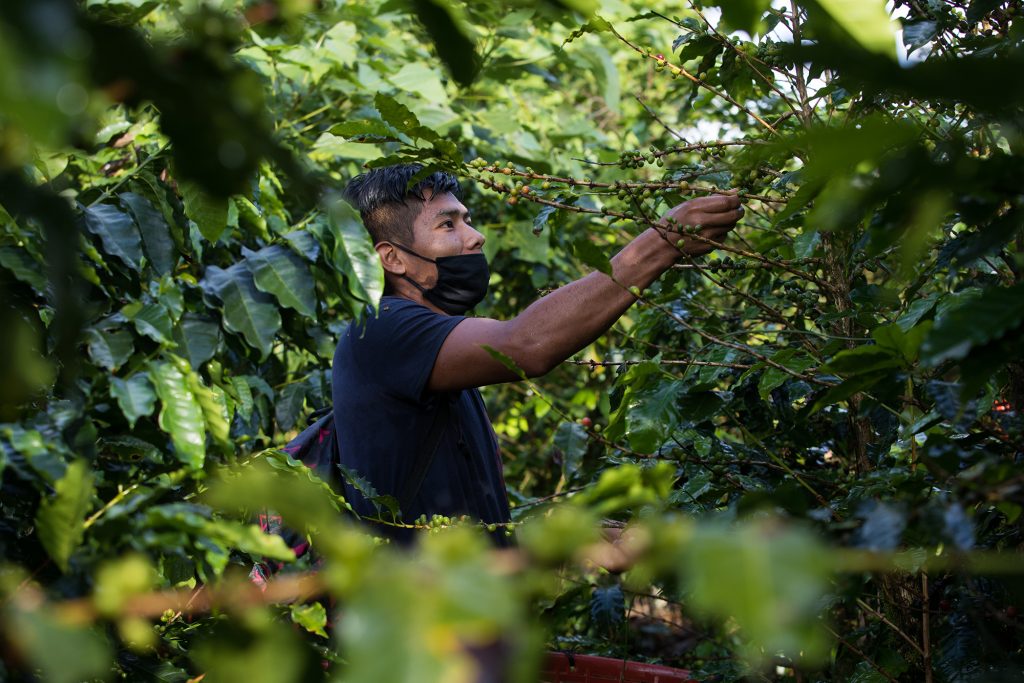
Monica Quesada Cordero/El Colectivo 506/National Geographic Society Covid-19 Emergency Fund
He also might move on to another farm, he says. This is common, especially since Costa Rica’s coffee doesn’t ripen all at once. It’s common that Ngöbe-Buglé workers in particular will begin in Coto Brus in September or October, then move up to Tarrazú or Dota, where the harvest doesn’t start to peak until mid-December. They might even move further up to Heredia or San Ramón and pick well into March. As we leave Sergio to get back to his dinner and his bunk bed, he’s not sure whether his wife will join him at Río Negro, or whether he alone, or they as a couple, will make their way to a farm further north. He hopes he can manage to earn enough to return to Panama with some savings. There’s no work for him in the comarca, he says. When he’s not at home in the indigenous territory, he lives in Panama City and works at a gas station.
If Sergio moves, he plans to go to a farm in Tarrazú that belongs to the same company that owns Finca la China. However, in this unusual year, workers’ movement among separately owned farms has taken on heightened import and drama. This is true for Maikol, watching his whiteboard, trying to figure out how to fill up his baches and staff the region’s biggest harvest. It’s true for smaller farmers, where the movement of just one or two people can cause significant upheaval.
Up in Tarrazú, Lucidia Hernández, walking back down the mountain from her brand-new dormitory, carrying her sleeping daughter as dusk gathers over the valley—pleased with her new building and the progress of the coffee harvest—is about to feel the sting.
Next in the series: The global pandemic has accentuated the economic strain and stress experienced by both coffee pickers and small farmers, and all the economies in which they participate. How does anyone make ends meet? We’ll take a look.
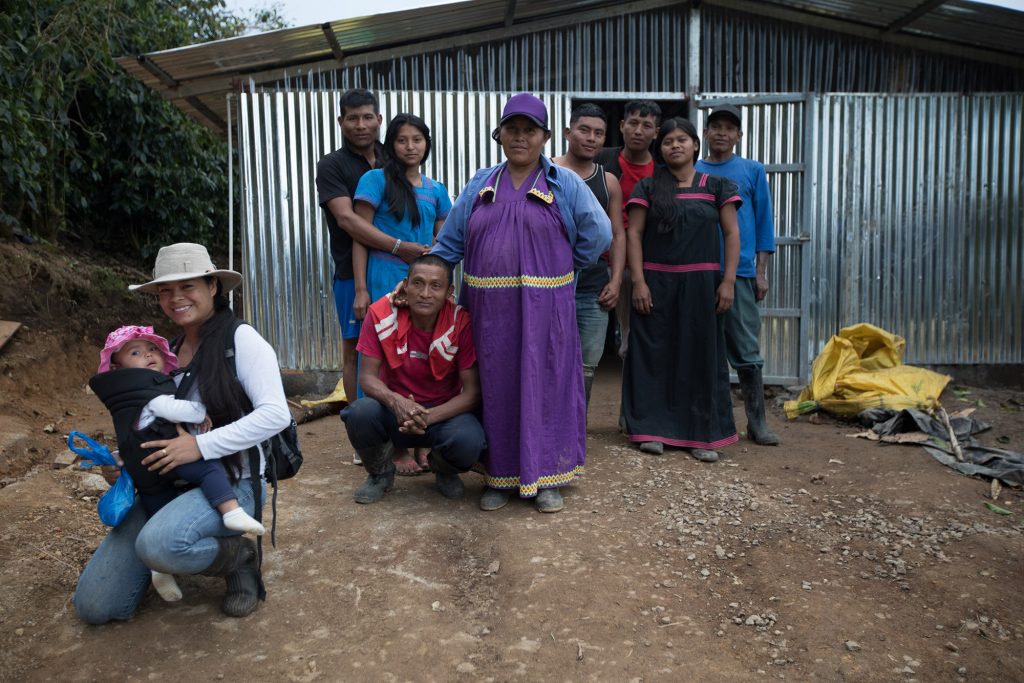
Monica Quesada Cordero/El Colectivo 506/National Geographic Society Covid-19 Emergency Fund


